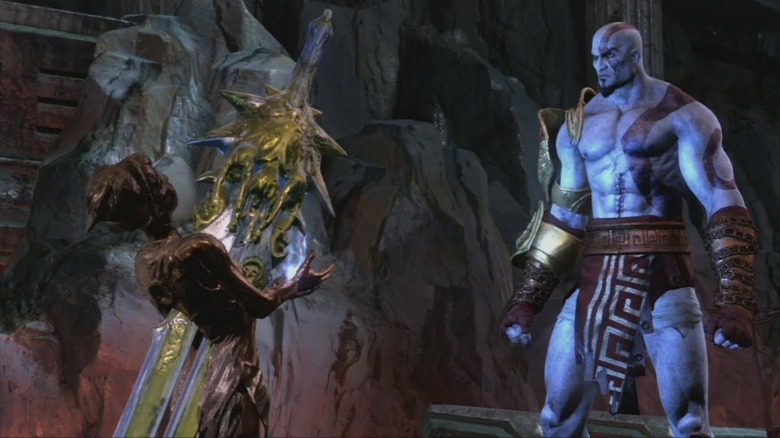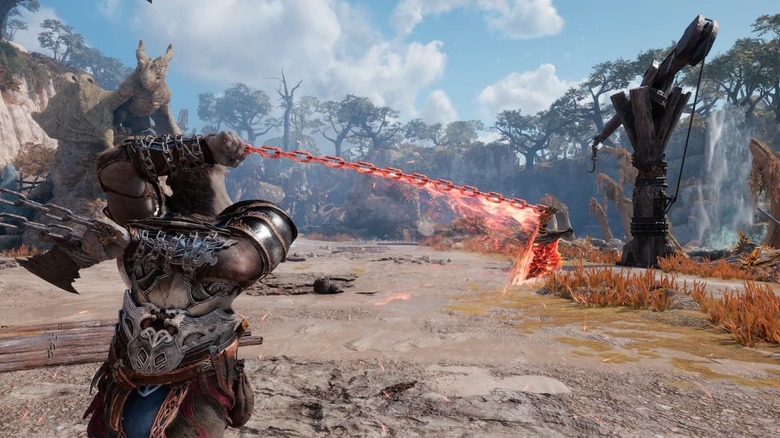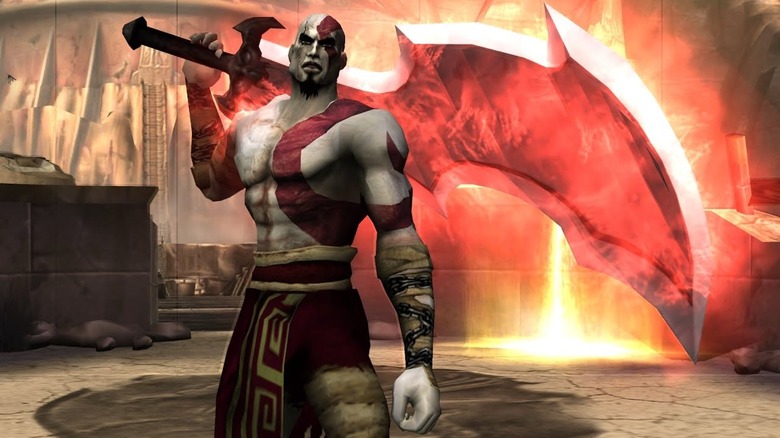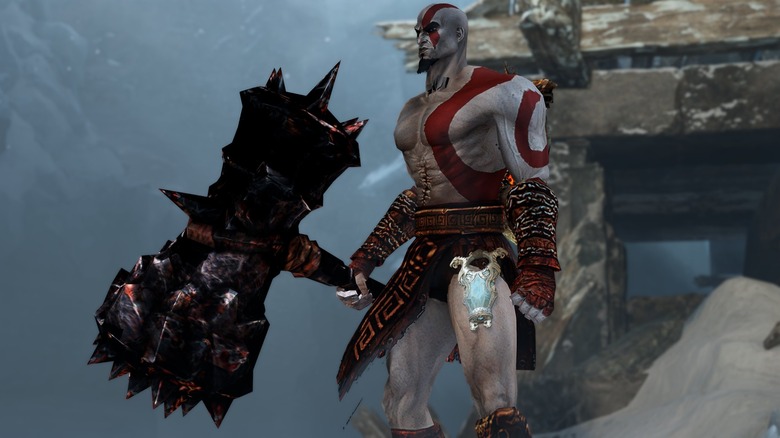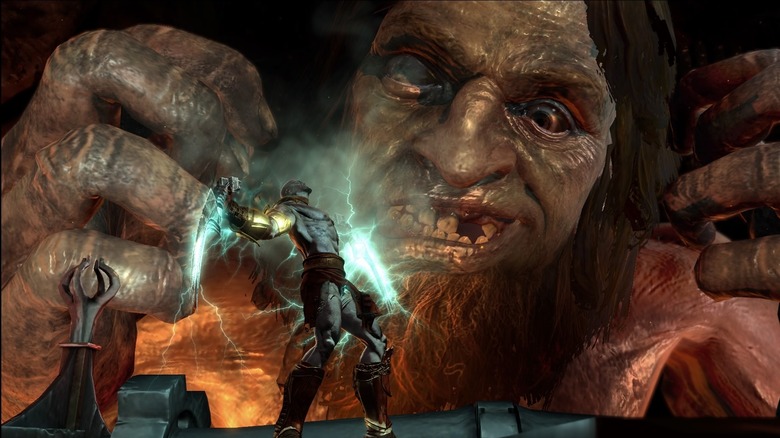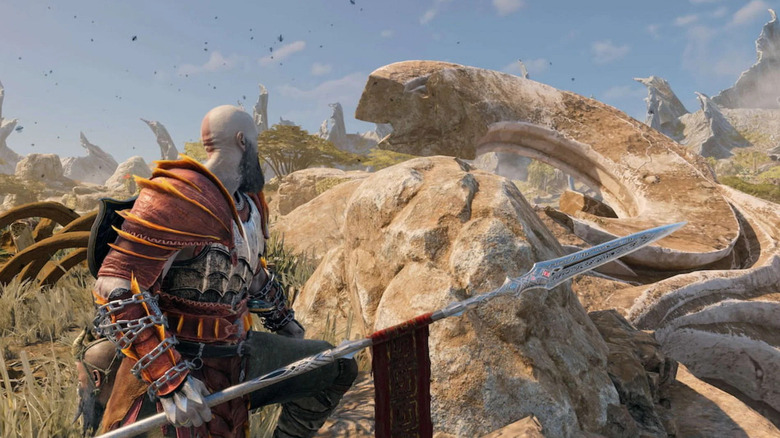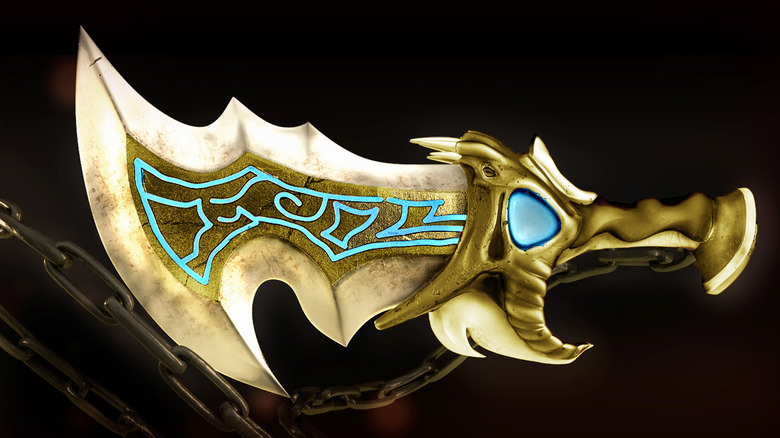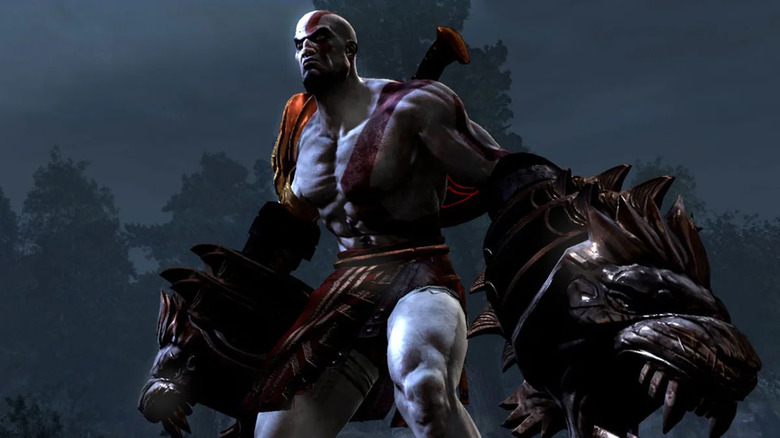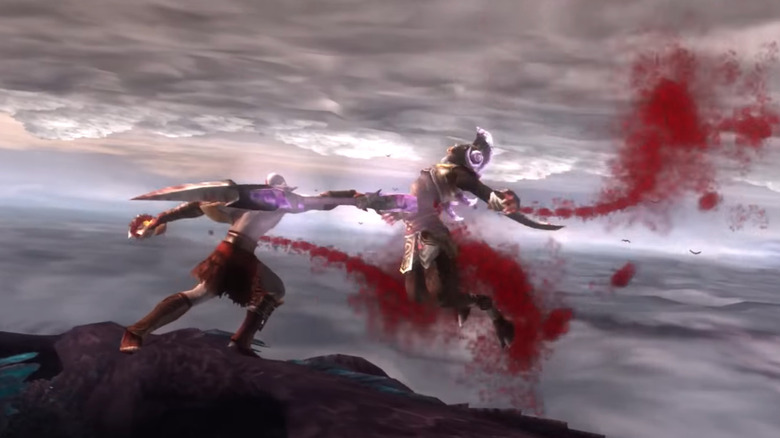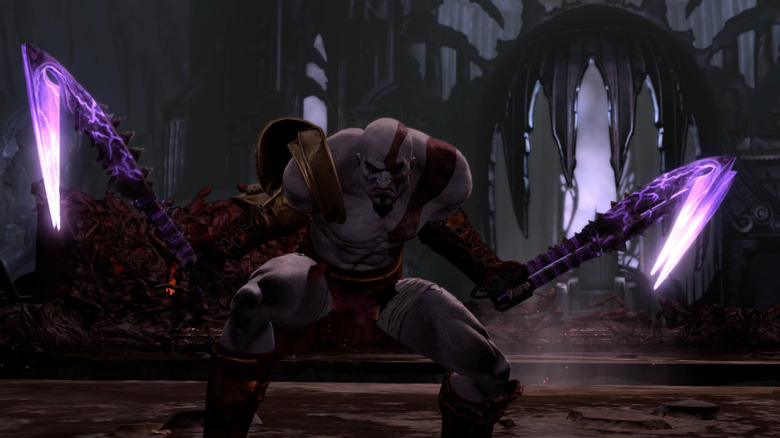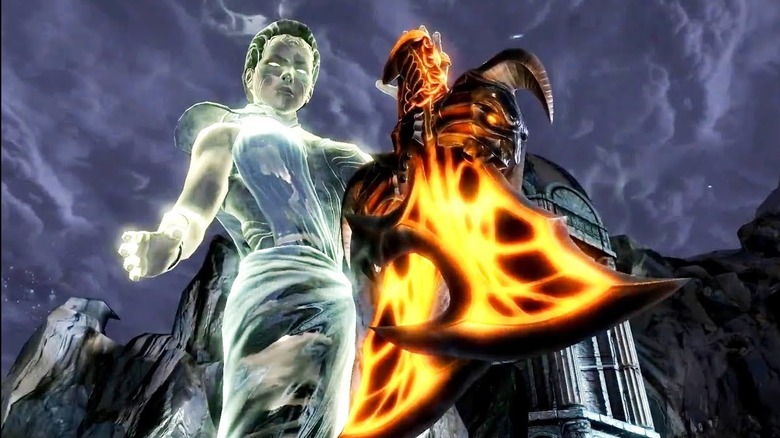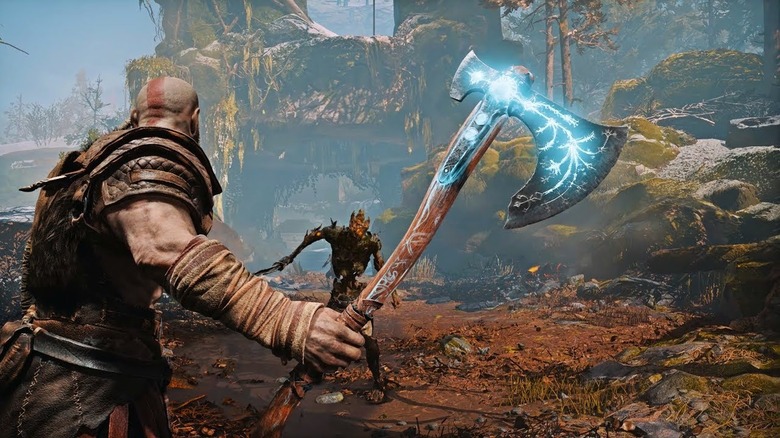The Most Powerful God Of War Weapons Of All Time
Video games are full of immediately recognizable weapons. Cloud Strife's hilariously big Buster Sword is as memorable as Samus' arm cannon or Sora's Keyblade. Some franchises pride themselves on constantly adding more distinct artillery to the mix, like when "Devil May Cry" added the outlandish Dr. Faust hat and the Cavaliere R motorcycle/buzzsaw. But when it comes to epic armaments, "God of War" is king.
Kratos is hellbent on taking revenge against the gods — and he needs the right equipment to do so. Of course he has his trusty Blades of Chaos, which have seen a few variations from game to game. These Blades are seen as Kratos' primary tool for many installments, but over the course of his adventures, the Ghost of Sparta has acquired many secondary weapons.
The majority of Kratos' journey has its roots in Greek mythology, but he also ventures into the Norse mythos in later chapters. This change in scenery affects what artillery he wields in the series' epic boss fights. With so many weapons and games to choose from, here are the most powerful armaments in the "God of War" series.
Blade of Olympus
Arguably the most powerful weapon in the canon is the Blade of Olympus, but its use in the series is tricky. Zeus constructed the sword to end the war with the titans, allowing him to finally banish the creatures. The lore doesn't end there, as the blade becomes the object of focus in the first few "God of War" sequels. "God of War 2" opens with Kratos fighting an enemy known as the Colossus of Rhodes. To help Kratos win the battle, Zeus graciously gifts the Spartan with the Blade of Olympus — but there's a twist.
As the player gets acquainted with the blade in the opening level, it is revealed that Zeus has ulterior motives. The blade sucks up all of Kratos' powers, leaving him vulnerable to Zeus' surprise attack. Luckily for Kratos, he's eventually able to alter time to rectify his fate. The Blade of Olympus is once again featured prominently in the final boss encounter with Zeus at the end of the trilogy.
Gameplay-wise, the sword is a bit lackluster, even though it appears in multiple titles. Gamers were disappointed to find that it functions as little more than a New Game+ bonus gimmick in "God of War 2." Despite its canonical power, it just doesn't have the combat potential that the Blades of Chaos and secondary weapons have. It can be upgraded as players go on, but it's a shame that it's so underwhelming in gameplay.
The Blades of Chaos
The iconic Blades of Chaos are Kratos' bread and butter. Series veterans typically prefer to upgrade the Blades as opposed to other items, because combo potential is higher at their peak performance. These blades are extremely multi-faceted; they can launch enemies, grapple smaller opponents, and continuously juggle all kinds of foes.
The original game sees Kratos buffing his trusty Blades on a level-to-level basis. Each level nets the Blades of Chaos more moves and increased damage scaling. In 2018's "God of War" and 2022's "God of War Ragnarok," the upgrade path is much more complex. Gamers can outfit the blades with a number of pommels and super moves that can be chained together.
Lore-wise, the Blades of Chaos are quite literally otherworldly, having been made in the underworld. These objects were given to Kratos by Ares, chains and all, representing his enslavement by the Greek god until his eventual defeat in the first entry. In the Norse duology, Kratos must retrieve the Blades before he heads to Helheim. Once in Helheim, the blades assist in taking down certain icy enemies and solving Winds of Helheim puzzles. "Ragnarok" takes things further, as the Blades of Chaos allow Kratos to quickly traverse walls and combat areas.
Blade of Artemis
Hands down the best strategy in the original "God of War" is to put all your orbs into upgrading the Blades of Chaos. There is really no reason to swap weapons, save for the Blade of Artemis. Now, this weapon shouldn't be treated as an outright substitute to the Blades of Chaos, but rather a situational replacement. Certain encounters may call for the raw strength of Artemis.
The Blade of Artemis has three different levels, but outside of level one, additional levels only increase its overall strength. Fans have noted that the sword is technically more powerful than Kratos' usual blades in an offensive sense, but inferior in other aspects. The Blades of Chaos simply outdo Artemis in range capability and overall combo progression.
But that doesn't necessarily mean Artemis is useless. A particular endgame encounter involves Kratos having to fend off foes to protect his imaginary family (no, really). This is a tough fight, but the Blade of Artemis can alleviate the stress. The launching move, "homerun," can help Kratos focus on more than one enemy, keeping him from being bombarded by an onslaught.
It makes sense that it would come in handy; the blade was wielded to slay a Titan. While it doesn't take center stage like many of the other swords in "God of War," the Blade of Artemis definitely has its uses.
Barbarian Hammer
Joining the list of raw power weapons is the Barbarian Hammer, which actually serves as an improvement on the Blade of Artemis. "God of War 2" players will likely put all their orbs in the Blades of Athena and the Blades of Chaos, but they might be missing out on a surefire winner. The Barbarian Hammer is such a strong secondary, even without leveling it up all the way.
The hammer is extremely limited in its move-set, but makes up for it in sheer strength. Players using the Barbarian Hammer will likely be spamming the triangle button, but the damage is staggering. Even sacrificing speed and range is worth it for strength alone. Leveling up the hammer is also imperative since rewards are even higher damage, and the power to summon cursed souls as a special move. However, another trade off is not being able to evade since the right stick summons the souls.
Alrik was known as the Barbarian King in "God of War 2," but once Kratos defeated him, the hammer fell into the Ghost of Sparta's hands. Technically, it is the most powerful tool in "God of War 2." It's much more useful than the heavy weapons found in other entries.
Nemesis Whip
"God of War 3" is unlike its predecessors in that it contains many viable weapons, meaning players don't feel like they need to stick to the Blades of Chaos. One of these is the Nemesis Whip. At first it may look and act similar to the Blades of Chaos, but it has many other factors going for it. This whip is extremely quick and has great range, giving players ample reason to switch to it every now and then. The Nemesis The whip's high-volume attack is also extra-effective against certain enemies, like the every-annoying Satyrs. It can also stop adversaries in their tracks with its electric stun, allowing players to continue attacking or switch to another weapon to mix up their combos.
In "God of War 3," Kratos receives help from Hephaestus in fashioning the whip. Once constructed, Hephaestus turns on Kratos and intends to kill the Spartan, but Kratos reverses the attack and instead kills Hephaestus. It's a jaw-dropping moment, and one that yields a handy tool. The benefits of utilizing the whip are rounded out with the way it can aid in building Kratos' Spartan Rage. Fans prefer the Nemesis Whip since it brings forth more orbs that add to Kratos' rage meter, which means more time using Kratos' powered-up form.
Draupnir Spear
"God of War Ragnarok" puts Kratos in the difficult situation of having to defeat Heimdall, the watchman of the Norse gods. Heimdall sees everything and is able to predict any movements against him, so Kratos, Brok, and Sindri are left to craft an item that can overwhelm Heimdall's senses: the Draupnir Spear. And not only is this weapon powerful within the game's story, but also during gameplay.
The Spear was forged from Odin's self-replicating ring, Draupnir. As a result of this charm, Kratos can continuously throw exploding spears to overpower enemies. Spear detonations become stronger as Kratos unlocks more skills. Due to its strengths as both a melee and ranged weapon, the Draupnir Spear allows for a decent amount of strategy. One move allows Kratos to slam the spear down into an enemy, which can be repeated multiple times with enough upgrades. But perhaps the most versatile ability is Elemental Siphon, which sees the Draupnir absorbing an enemy's elemental ability and adding it to Kratos' melee damage for a limited time. Of course, in terms of sheer fun, this strategy pales in comparison to just endlessly throwing the Draupnir.
Like the Blades of Chaos, the Draupnir Spear is also needed for puzzles and platforming, as the weapon can be used as a foothold in order to scale higher ledges.
Blades of Athena
Completing the first "God of War" will earn players the Blades of Athena. These are essentially a copy of the Blades of Chaos aside from their appearance, only meant to symbolically reflect Kratos' newfound godhood after defeating Ares. However, in the sequel, the Blades of Athena completely replace the Blades of Chaos. After getting his powers taken away, Kratos has to once more upgrade his blades to unlock the usual moves and damage buffs.
Most of the move-set attached to the Blades of Athena is relatively identical, complete with the usual launchers and light/heavy attacks. Fans of the "Metroid" series will feel right at home upon learning they have to unlock a ton of moves that were already utilized in the previous game. But while there are shared moves between the weapons, Athena's blades do have notable differences, like the addition of the Icarus Lift move. In "God of War 2," Kratos jumps off of a bridge and gets a hold of Icarus, ripping off the god's wings and making them his own. This introduces Icarus Lift to Kratos' arsenal, offering gliding and heightened jump abilities for some light platforming and puzzle solving.
In "God of War 3," the Blades of Athena are replaced by the Blades of Exile once Kratos falls into the River Styx. However, by equipping Aphrodites' Garter for a replay of the third game, the Blades of Athena can be kept for the duration of the story.
Nemean Cestus
The Nemean Cestus was Hercules' go-to weapon, so of course it's one of the strongest in the franchise. An epic boss fight in "God of War 3" sees Kratos duking it out with his half-brother in a large arena. For the majority of the battle, Hercules swings the Nemean Cestus around while waves of enemies charge Kratos. This eventually turns into a one-sided showdown when Kratos rips the gauntlets from Hercules and uses them against him.
After bashing Hercules' head into the arena, Kratos keeps the Nemean Cestus. And this is far from just another throwaway weapon. The gauntlets can break through Onyx, which is required to progress through the many enemies bearing shields and armor made from the material. No other tool in the game can do this, so when Kratos finds himself surrounded by Onyx-clad enemies, it's time to switch to the gauntlets. That isn't the only benefit to wielding these gauntlets, however. The Nemean Cestus may be a slow-moving weapon, but it is good for crowd control. Ground slam attacks cause an area of effect that hits all enemies in the vicinity, while the weapon's grappling moves, evasion techniques, and surprisingly useful air attacks add to its versatility.
Spear of Destiny
Though it's not as complex or as fun as the Draupnir from "Ragnarok," the Spear of Destiny is still an excellent piece in Kratos' arsenal. "God of War 2" already has the Blades of Chaos and the Barbarian Hammer, so what need does Kratos have for a spear? Well the Spear of Destiny more than proves its worth. Firstly, it has excellent functionality as a ranged weapon. Kratos can unleash wide arc movements with the Spear of Destiny to keep enemies at bay, then end combos with a series of devastating thrusts.
The Spear of Destiny also preceded the Draupnir's explosive capabilities. It's the closest thing Kratos has to shooting an actual gun, since he can fire blasts from the end. Purple explosives litter the screen as enemies are getting caught between explosive traps, which can be dropped between offensive moves. The spear's mines have a decent range, knocking back enemies in the immediate area.
Ultimately, though, many players may find the journey to acquire the spear to be more interesting than the spear itself. "God of War 2" features gameplay sections in which Kratos rides a pegasus and destroys griffins, which is as cool as it sounds. This leads to a showdown with the Dark Rider, who (true to his name) rides atop the Dark Griffin and uses the Spear of Destiny against Kratos. The Ghost of Sparta has to brutally vanquishes the Dark Rider and his steed to receive the spear as a reward.
Claws of Hades
Originally owned by Hades himself, the Claws of Hades are a force to be reckoned with. In an epic multi-phase boss encounter with the ruler of the underworld during "God of War 3," Kratos uses his Blades as a pulley to slam Hades into the arena ceiling. Hades then drops the Claws, which allows Kratos to finish off the god with his own weapon. It's a nice touch, since Hades' final phase is pretty much a practice session for Kratos' new item. Hoards of the undead surround Kratos, forcing the player to figure out the best strategies for the Claws.
Players can cancel a swing of the hooks and go into a roll, allowing Kratos to build up a combo and then evade soon after as a safety precaution. It's also noted that Kratos' dodge is quicker and longer with the Claws of Hades, since he is literally pulling himself along with the chained weapon. For these reasons alone, the Claws of Hades should be upgraded after the player has maxed out Kratos' standard blades.
Probably the biggest advantage that the Claws of Hades have over other "God of War 3" arms is its summoning ability. Very much like the Barbarian Hammer's special move, the Claws of Hades can summon dead souls of fallen enemies to mob opponents. As the claws are upgraded, more souls are called upon.
Blades of Exile
"God of War 3" had its own variation of Kratos' signature weapon known as the Blades of Exile. This weapon visually differs from the other versions with the demonic heads and unique flaming patterns built into its design. Just like the Blades of Athena, these objects have to be leveled up to make them really worth it. Additional power boosts come with each upgrade, and they're totally worth unlocking.
At higher power levels, Kratos can perform some truly awesome moves like the Hyperion Ram, which pulls enemies towards him ending in a body slam. He is also able to pick up enemies and use them as battering rams to slam against walls or even other opponents. Like the other chained blade weapons, the Blades of Exile also act as a tool to move around levels. Even the Icarus Wings make a return to aid Kratos in crossing wide gaps. The Blades of Exile also allow for more vertical movement than the first two "God of War" entries. For instance, Kratos can use them to slide down walls, rather than slowly climb down.
The Leviathan Axe
The soft reboot of "God of War" arrived in 2018 with some massive changes. Alongside the new camera perspective and more heartfelt story came the addition of the Leviathan Axe. Kratos doesn't start the game with his usual blades, but rather a magical axe that could be recalled (similar to Thor's hammer, Mjolnir). As it turns out, the Leviathan Axe was made by the dwarven blacksmiths Brok and Sindri to combat Mjolnir's strength.
The axe allows for light and heavy attacks that differentiate based on the player's inputs. A light attack is a quick hit for mid-combo moves, whereas heavy attacks are powerful charge moves best used when far back from enemies. Certain bosses are weak to the axe, as well, which ups the strategy. For instance, Baldur can absorb elemental attacks, so Kratos will want to dole out icy axe moves when Baldur is in his fire state.
"Ragnarok" retains a lot of the Leviathan Axe's previous moves, but adds some welcomed alterations, including new attacks and a new look. Some upgrade in "Ragnarok" will cause the axe to evolve into a more ornate form. The axe can also be used to solve puzzles by freezing platforms and geysers to allow for safe passage. Overall, Kratos' magical axe rivals the Blades of Chaos as one of his best armaments ever.


